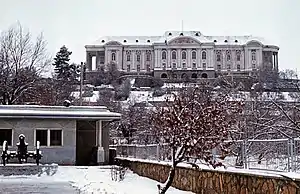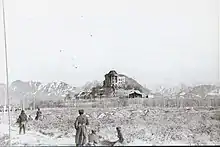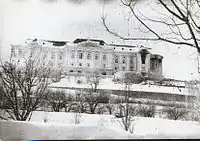Tajbeg Palace
Tajbeg Palace or Tapa-e-Tajbeg (Pashto: د تاج بېګ ماڼۍ; Persian: قصر تاج بيگ; Palace of the Large Crown), also inaccurately called the Queen's Palace, is a palace built in the 1920s and located about 10 miles (16 km) south-west outside the centre of Kabul, Afghanistan.[1] The once stately mansion sits atop a knoll among foothills where the Afghan royal family once hunted and picnicked. It should not be confused with Darul Aman Palace, which is roughly 1.3 kilometres (0.81 mi) northeast from Tajbeg Palace.


Built to house the Afghan royal family, Tajbeg Palace is one of the most impressive landmarks of "Darulaman," newly created during the era of Amānullāh Khān by a team of European architects in an attempt to establish a new seat of government and modernise Afghanistan, both of which ultimately failed when religious conservatives forced Amānullāh from power and halted his reforms. The palace was eventually used as governmental and military houses until it was damaged, leaving it in ruins. The palace is under restoration and will be rebuilt completely by early 2021.[2]
History
Not far from the castle or Tapa e Taj Beg (Taj Beg hill), a palace for the Queen of the Timurids is said to have been found a long time ago. Terraced garden designs were preferred by Timurids and Moguls, and today some ruins remain. The Timurids and their successors, the Moguls, have kinship relations with the Pashtun tribes of Abdali Durrani and later Yusufzai. The daughter-in-law of Ahmad Khan Abdali (the wife of Timur Shah Durrani) was the daughter of Alamgir II.
According to some historians, the palace seems to have been renovated by Zaman Shah Durrani in 1795 (1210 AH), which was subsequently destroyed in military conflicts, and the ruins from ancient times remain. Foreign soldiers of ISAF have documented ruins of the former castle.[3]
On December 27, 1979, the Union of Soviet Socialist Republics launched its intervention in Afghanistan. That evening, the Soviet military launched Operation Storm-333, in which some 700 troops, including 54 KGB spetsnaz special forces troops from the Alpha Group and Zenith Group, stormed the Palace and killed President Hafizullah Amin, who had resided there since December 20.[4]
During the Soviet–Afghan War it served as the headquarters of the Soviet 40th Army. The palace was severely damaged in the years after the Soviet withdrawal, when different mujahideen factions fought for control of Kabul after the fall of President Najibullah's Moscow-backed government in 1992.
The Afghan government, in conjunction with the German government, have drafted plans for renovating the palace for official use, requiring funds from private donations from wealthy Afghans. These plans were on indefinite hold as the Afghan government seeks to establish peace and stability.[5] A similar plan was approved for the nearby Darul Aman Palace which was completely renovated and opened to the public on Afghan Indendence Day, August 2019.
The Palace is (as of December 2020) undergoing restoration.[6]
Gallery
 Tajbeg Palace in 2012
Tajbeg Palace in 2012 Bird's eye view of the palace in 2012
Bird's eye view of the palace in 2012 The ruined palace
The ruined palace.jpg.webp) The ruined palace
The ruined palace Photograph of the palace's west side during the Soviet assault on 27 December 1979
Photograph of the palace's west side during the Soviet assault on 27 December 1979 The palace one day after the assault
The palace one day after the assault
References
| Wikimedia Commons has media related to Tajbeg Palace. |
- Ghani, Mariam & Ashraf (8 September 2012). "Palace of Abandoned Dreams". The New York Review of Books. Retrieved 27 December 2015.
- "SketchUp Buildings". sketchupbuildings.blogspot.com. Retrieved 10 August 2015.
- http://afghanistanmylasttour.com/tag/tajbeg-palace/ 14th century Mongol ruins, the historical Taj Beg Palace
- Humanitarian Invasion: Global Development in Cold War Afghanistan by Timothy Nunan
- "Everywhere: Places: Darul Aman Palace". everywheremag.com. Archived from the original on 21 December 2009. Retrieved 10 August 2015.
- {{cite web|url=https://www.youtube.com/watch?v=cGyg-Wq0WVA&list=WL&index=10%7Ctitle=Zaman-Tajbeg Palace Kabul - Afghanistan
External links
| Wikimedia Commons has media related to Tajbeg Palace. |